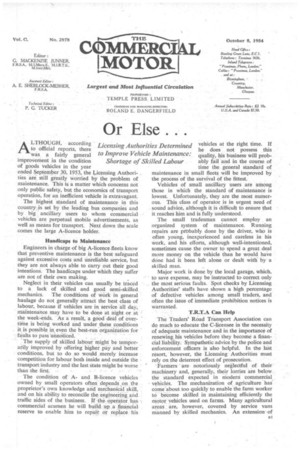Or Else . . • A LTHOUGH, according to official reports,
Page 35

Page 36

If you've noticed an error in this article please click here to report it so we can fix it.
there was a fairly general improvement in the condition of goods vehicles in the year ended September 30, 1953, the Licensing Authorities are still greatly worried by the problem of maintenance. This is a matter which concerns not only public safety, but the economics of transport operation, for an inefficient vehicle is extravagant.
The highest standard of maintenance in this country is set by the leading bus companies and by big ancillary users to whom commercial vehicles are perpetual mobile advertisements, as well as means for transport. Next down the scale comes the large A-licence holder.
Handicaps to Maintenance Engineers in charge of big A-licence fleets know that preventive maintenance is the best safeguard against excessive costs and Unreliable service, but they are not always able to carry out their good intentions. The handicaps under which they suffer are not of their own making.
Neglect in their vehicles can usually be traced to a lack of skilled and good semi-skilled mechanics. The conditions of wark in general haulage do not generally attract the best class of labour, because if vehicles are in service all day, Maintenance may have to be dole at night or at the week-ends. As a result, a good' deal of overtithe is being worked and under ,these conditions it is possible in even the best-run organization for faults to pass unnoticed.
The supply of skilled labour might be temporarily improved by offering higher pay and better conditions, but to do so would ,merely increase competition for labour both inside and outside the transport industry and the last state might be worse than -the first.
The condition of Aand B-licence vehicles owned by small operators often depends on the proprietor's own knowledge and mechanical skill, and on his ability to reconcile the engineering and traffic sides of the business. If the aperaior.has commercial acumen he will build up a financial reserve to enable him to repair or replace his vehicles at the right time. If he does not possess this quality, his business will probably fail and in the course of time the general standard of maintenance in small fleets will be improved by the process of the survival of the fittest.
Vehicles of small ancillary users are among those in which the standard of maintenance is lowest. Unfortunately, they are the most numerous. This class of operator is in urgent need of sound advice, although it is difficult to ensure that it reaches him and is fully understood.
The small tradesman cannot employ an organized system of maintenance. Running repairs are probably done by the driver, who is often young, inexperienced and careless in his work, and his efforts, although well-intentioned, sometimes cause the owner to spend a great deal more money on the vehicle than he would have done had it been left alone or dealt with by a skilled man.
Major work is done by the local garage, which, to save expense, may be instructed to correct only the most serious faults. Spot checks by Licensing Authorities' staffs have shown a high percentage of defective vehicles among small traders, and often the issue of immediate prohibition notices is warranted.
T.R.T.A Can Help The Traders' Road Transport Association can do much to educate the C-licensee in the necessity of adequate maintenance and in the importance of renewing_ his vehicles before they become a financial liability. Sympathetic advice by the police and enforcement officers is also helpful. In the last resort, however, the Licensing Authorities must rely on the deterrent effect of prosecution. ' Farmers *are, notoriously neglectful of their machinery and, generally, their lorries are below the standard expected in niodern commercial" vehicles. The mechanization of agriculture has come 'about too quickly to enable the farm worker tO become skilled in maintaining efficiently the motor vehicles used on farms. Many agricultural areas , are, however, covered by service vans manned by skilled mechanics. An extension of these facilities and their widespread acceptance by farmers would be of great assistance in improving the condition of vehicles.
It is to be hoped that the relaxation of restrictions on hire purchase will help small operators to replace their vehicles more frequently. The farmer in particular should benefit, because he has to lay out large sums for 12 months before he can recoup himself from the sale of his crops.
Manufacturers often provide factory-trained mechanics to service vehicles in many centres, but the operators of older vehicles do not always take advantage of these facilities. The distance from the service station is a deterrent, apart from which the operators probably fear that more faults than those immediately obvious will be found and that a large bill will be incurred. Consequently, they resort to a make-do-and-mend policy, using the services of the nearest garage.
A great deal has been done in the way of education by the professional engineering institutions and the technical Press, but generally it is the larger operator who has benefited most. Much work in education still lies ahead. Operators who do not take advantage of facilities for instruction in maintenance place themselves at the mercy of the Licensing Authorities and the police, who are growing ever more determined that defective vehicles shall be put in roadworthy condition before accidents happen.




























































































